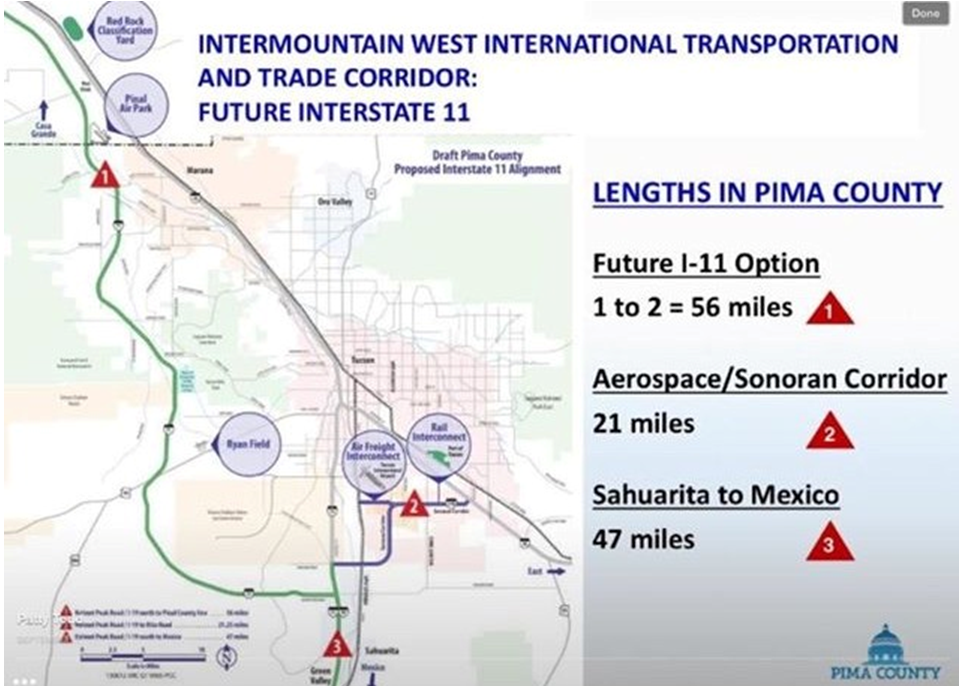
by Albert Vetere Lannon, member Avra Valley Coalition
On October 8 Pima County Administrator Chuck Huckelberry sent the Board of Supervisors a memorandum saying, “We have commissioned an Economic Revenue and Impact Study for the Sonoran Corridor…perhaps the single largest economic development initiative in the last 50 years within Pima County.”
The problem is that the Sonoran Corridor, which is slated to receive $30 million in funding from the Pima County bonds package to be voted on November 3 as Proposition 425, seems to be in clear violation of the Board of Supervisors’ own Resolution 2007-343. That resolution states unambiguously that the Supervisors “oppose the construction of any new highways in or around the County that have the stated purpose of bypassing the existing Interstate 10 as it is believed that the environmental, historic, archaeological, and urban form impacts could not be adequately mitigated.” A copy of Resolution 2007-343 is available click here.
The Sonoran Corridor, which is an integral part of Interstate 11 on maps from the County Administrator’s office (see additional attachment) links up with his proposed Avra Valley I-11 route that critics believe will destroy the communities, wildlife and archaeological riches of the area. The Arizona Department of Transportation’s own numbers show that double-decking just six miles of Interstate 10 would do everything I-11 would do regarding traffic, at one-third the cost. That would save taxpayers nearly $2 billion.
I-11 has garnered bipartisan political support led by Senator John McCain, and the County Administrator appears to be using the bond measure, which ties the Sonoran Corridor to politically popular road repairs, as a way to make his Avra Valley alignment a logical choice, linked directly to the new “auxiliary” highway, now numbered “410.” Arizona’s Department of Transportation is in the early stages of a $15 million Tier One Environmental Impact Study of I-11 from Wickenburg to Nogales.
Federal and state highway planners use different terms for different kinds of roads. An “auxiliary,” which the county’s map calls the Sonoran Corridor, is generally classified as a “bypass” connecting to a parent route at both ends. A spur route is similar, but the first digit of its designation is an odd number while a bypass carries an even first digit.
By the County Administrator’s own designations, the Sonoran Corridor, “State Route 410, Future Auxiliary Interstate Highway,” is a bypass and therefore in apparent violation of Resolution 2007-343. Earlier requests to the County Attorney’s office for a legal opinion were ignored and a new request was submitted.
The study itself was prepared by Applied Economics LLC of Phoenix at an unspecified cost. According to Arizona Corporation Commission filings Applied Economics was incorporated just last year. Their client list includes Cardon Development. Earlier published Avra Valley Coalition research showed that several Cardon companies own hundreds of acres of land along the route residents have dubbed the “Huckelberry Highway.”
When Wilford Cardon ran unsuccessfully for Arizona Secretary of State prominent on his campaign committee were Don Diamond and Diamond Ventures President David Goldstein. The Sonoran Corridor borders Diamond’s planned 3000 acre Swan Southlands development, shown on the study’s map as “Verano.”
The Applied Economics study discusses “potential” economic impacts that “could occur…based on a series of assumptions.” It reminds us of the old saying, “If we had some ham we could have some ham and eggs if we had some eggs.”
The study’s value, except as Bonds/Sonoran Corridor/I-11 campaign material improperly paid for by taxpayers, is questionable at best. The study is available on the Pima County website under “County Administrator’s office, Memoranda and Correspondence to the Board of Supervisors.”
